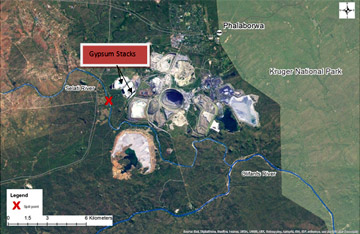Danny Govender, Stefanie Freitag-Ronaldson, Eddie Riddell and Robin Petersen

Figure 1. Map showing spill site on the Selati River |
On the 30th of December 2013, wildlife authorities in the Kruger National Park were alerted to a large fish kill on the Selati River in the Palaborwa area, just outside the Park. Upon investigation, it was found that one of the large industries in the Phalaborwa Mining Complex was discharging highly acidic process water into the Selati River. By the 31st acidic tailings water continued to gush out uncontrolled, and no attempt to notify authorities was made by the company. When called on site, they blamed the high rainfall experienced the proceeding weekend, for the overflow from the phosphogypsum tailings dams.
Immediate emergency response meetings were called, initially facilitated by the Ba-Palaborwa disaster management unit, to stop any further pollution. Nevertheless, unauthorized discharge of polluted water from the Bosveld Phosphates fertilizer production plant continued into the Selati River until 5 January 2014. The very acidic conditions resulted in immediate acute toxicity and death for a variety of fish species of all ages in both the Selati River and the Olifants River over more than 20 kilometers downstream of the spill site (see map). Although the company are not able to quantify the exact volumes, a very large amount of ‘dirty water’ (water contaminated with acid and other pollutants including salts and heavy metals) has flowed directly into Kruger’s river system, and on into Mozambique.
Phospho-gypsum is an acidic by-product of the phosphate fertilizer industry, which is created during the production of phosphoric acid from phosphate rock slurry. Process water from this type of industry is usually very acidic, contains high levels of dissolved salts (such as sulphates, fluorides, phosphates), heavy metals in solution (including aluminium, zinc, arsenic, manganese, copper, iron) and is moderately radioactive. A spill could therefore have both, acute toxicity as well as longer term ecological effects. The acute fish kills, as was seen here, is often due to the low pH causing irritation to the gills. In response, the gills produce more mucous which eventually results in death due to oxygen deprivation. Affected fish in this case were seen at the surface of the water, gulping for air, a very visible impact. However, the longer term impact of nutrient pollution and heavy metals can lead to changes in stream community composition as well as oxidative stress, birth defects and carcinogenic effects in longer-lived aquatic organisms.
In addition, and due to the nature of the industrial activity taking place in the Phalaborwa complex, there is a serious concern about groundwater contamination. As groundwater contributes to basal flow to Rivers in the dry season, contamination of groundwater stores can have major longer term impact on the water quality of both the Selati and Olifants Rivers’.
Criminal charges have been laid against the company relating to non-compliance and contravention of sections of the National Water Act (1998). These are being further investigated by the Department of Water Affairs’ Compliance Monitoring and Enforcement team (Blue Scorpions) as well as the Department of Environmental Affairs’ Green Scorpions. The Department of Water Affairs, Department of Environmental Affairs and South African National Parks are continuing to cooperate closely on both the operational responses and the investigation associated with this incident. There is already some suggestion that the problem is far worse than just an isolated incident, and ailing infrastructure on the plant may have contributed to more chronic seepage to both the ground and surface waters. Just how far back this goes and to what degree needs further investigation.
This bares direct relevance to the health risks of living close to this “Toxic” River, moreover for communities subsisting directly off it in the lower catchment. The diverse mix of nutrients, agrochemicals, metals, and salts from the heavy industry, mines, domestic and agricultural discharges from the upper and middle catchment are made worse by the mining industry just outside the KNP, further contributing to the deteriorating water quality. Since this particular effluent spill was discovered and the resulting increased vigilance in the area, there have been 5 other unauthorized discharges from mines in the Phalaborwa complex.
SANParks scientists and managers are concerned that industry is not adapting fast enough to climate variability in their risk management approaches and that further incidents of this nature may become more frequent, not only here but across the country. Mining and industry must become more proactive and be able to adapt their operations to the increasing climatic variability. Without this, essential mixed land-use practices and approaches will not work and the environment, together with rural populations, will be forced to bear the escalating immediate and long-term costs of pollution.
|